
To K Holl's visit to Ostrava
In mid-October, American architect Steven Holl visited Ostrava to present his winning design for a new concert hall to the public. At a time of tightened health measures, this was only possible on the third attempt. Holl arrived a day early to view his traveling exhibition Steven Holl: Making architecture | Ostrava, which had its opening a month earlier at GVOU. His busy Thursday program began with a brief morning stop at the seated Janáček statue (David Moješčík, 2017) at Jirásková Square, after which he moved on to a press conference at the glass Skelet café with a direct view of the Cultural House. The opening speech was given by Ostrava's mayor Tomáš Macura, whom one can consider the spiritual father and a great supporter of the new music hall project. Ostrava has been striving for a similar building for a long 160 years. During that time, six competitions took place, with the last one occurring more than half a century ago. The current seventh attempt has progressed further than any before, and if everything goes as planned, excavation work should begin in September 2022. This is not the only cultural building that has been decided upon for construction in Ostrava. In addition to the recently completed Kunsthalle at the site of the former Municipal Slaughterhouse, there is also the Faculty of Arts of the University of Ostrava, Pavilion G at Černá louka, the extension of the House of Arts known as the White Shadow, and significant progress on the delayed Moravian-Silesian Scientific Library, which is to be built opposite Holl's building. Examining the examples of new concert halls in nearby Poland, one can trace how modern architecture that arose from international competitions has helped to energize social life and the economy in the city. During his October visit, Holl was able to personally get acquainted with the Silesian metropolis for the first time. He also had the chance to see the House of Culture (Jaroslav Fragner, 1961) live, which is to be complemented by his levitating case for musical instruments. Conversely, Martin Kropáč, a native of Ostrava and Holl's longtime collaborator, has a profound grasp of the entire city and the specific location, which was decisive during the competition two years ago.
Before the pandemic, Holl undertook over thirty flights annually. Now, with the world having shut down and Holl voluntarily confined to his country house in Rhinebeck, from where he remotely managed his New York studio, he has been striving to ensure that no projects worldwide experience delays, which has so far been successful for the Ostrava concert hall, which is expected to cost a total of 2.6 billion CZK, including the reconstruction of Fragner's building while accounting for current price fluctuations. At the end of the press conference, three out of four journalists' questions were directed specifically at finances, with little interest in the world-renowned architectural figure sitting before them at that moment, and an awareness of the significance of the building which will become a catalyst affecting future generations. The morning disappointment was fully compensated for by the afternoon debate in the main hall of the House of Culture, which was filled to capacity not only with students but also with colleagues who readily traveled from across the country to see Holl. The discussion evening, moderated by Tomáš Čech, included Martin Kropáč, the co-author of the winning design for the Ostrava concert hall, alongside Steven Holl on stage. Ostrava did not follow the path of the second Guggenheim in Bilbao, which would lure solely with a world-famous name and unique architecture; instead, the resulting design incorporates current ecological trends as well as the skills of domestic craftsmen. It also acknowledges a different economic situation than what exists in America or Western Europe, which is reflected in the selection of materials. The revolutionary construction with diagonal beams helped save up to 30% of materials compared to a standard orthogonal system. With regard to energy savings, 125 boreholes (110m deep) will be used for geothermal pumps that will manage heating and cooling. In this way, the building will avoid air conditioning units that could create undesirable noise and vibrations that impede high-quality music listening, and thus the building's foundations have also been acoustically insulated against noise from the surroundings.
Holl's visit to Ostrava was his first work trip after nearly a year of hiatus due to the global lockdown. That he chose to go to northern Moravia speaks to the importance he places on the building for the Janáček Philharmonic Ostrava. This is not a polite phrase he would express at each project anywhere in the world. In Holl's work, music plays an irreplaceable inspirational role, yet throughout his forty-year career, he has not managed to realize a building directly for musicians, and Ostrava could fulfill that dream. During the pandemic, Holl managed to complete the cultural center Cofco in Shanghai or open an exhibition in Bellevue, Washington, but all remotely. He was unable to attend either of these events in person. In Ostrava, he managed to do both: conduct his exhibition, engage in discussions with the audience, and sign all documents so that the project could continue to advance successfully.
The exhibition at GVUO has been extended until the beginning of January next year due to high interest, which will make Holl's presence in Ostrava more prominent, as at that time the acoustic model of the concert hall, scaled according to the design by Nagata Acoustics and produced by professionals from the Czech company Aveton, is to be presented to the public.
Before the pandemic, Holl undertook over thirty flights annually. Now, with the world having shut down and Holl voluntarily confined to his country house in Rhinebeck, from where he remotely managed his New York studio, he has been striving to ensure that no projects worldwide experience delays, which has so far been successful for the Ostrava concert hall, which is expected to cost a total of 2.6 billion CZK, including the reconstruction of Fragner's building while accounting for current price fluctuations. At the end of the press conference, three out of four journalists' questions were directed specifically at finances, with little interest in the world-renowned architectural figure sitting before them at that moment, and an awareness of the significance of the building which will become a catalyst affecting future generations. The morning disappointment was fully compensated for by the afternoon debate in the main hall of the House of Culture, which was filled to capacity not only with students but also with colleagues who readily traveled from across the country to see Holl. The discussion evening, moderated by Tomáš Čech, included Martin Kropáč, the co-author of the winning design for the Ostrava concert hall, alongside Steven Holl on stage. Ostrava did not follow the path of the second Guggenheim in Bilbao, which would lure solely with a world-famous name and unique architecture; instead, the resulting design incorporates current ecological trends as well as the skills of domestic craftsmen. It also acknowledges a different economic situation than what exists in America or Western Europe, which is reflected in the selection of materials. The revolutionary construction with diagonal beams helped save up to 30% of materials compared to a standard orthogonal system. With regard to energy savings, 125 boreholes (110m deep) will be used for geothermal pumps that will manage heating and cooling. In this way, the building will avoid air conditioning units that could create undesirable noise and vibrations that impede high-quality music listening, and thus the building's foundations have also been acoustically insulated against noise from the surroundings.
Holl's visit to Ostrava was his first work trip after nearly a year of hiatus due to the global lockdown. That he chose to go to northern Moravia speaks to the importance he places on the building for the Janáček Philharmonic Ostrava. This is not a polite phrase he would express at each project anywhere in the world. In Holl's work, music plays an irreplaceable inspirational role, yet throughout his forty-year career, he has not managed to realize a building directly for musicians, and Ostrava could fulfill that dream. During the pandemic, Holl managed to complete the cultural center Cofco in Shanghai or open an exhibition in Bellevue, Washington, but all remotely. He was unable to attend either of these events in person. In Ostrava, he managed to do both: conduct his exhibition, engage in discussions with the audience, and sign all documents so that the project could continue to advance successfully.
The exhibition at GVUO has been extended until the beginning of January next year due to high interest, which will make Holl's presence in Ostrava more prominent, as at that time the acoustic model of the concert hall, scaled according to the design by Nagata Acoustics and produced by professionals from the Czech company Aveton, is to be presented to the public.
The English translation is powered by AI tool. Switch to Czech to view the original text source.
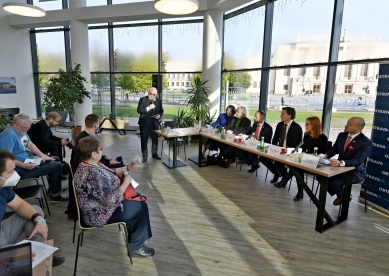
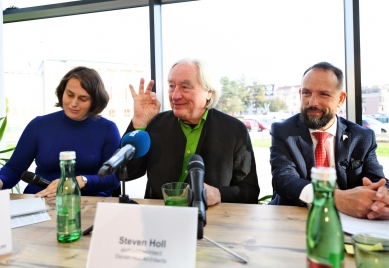
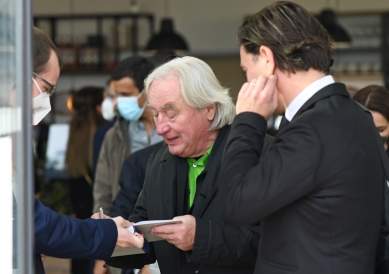
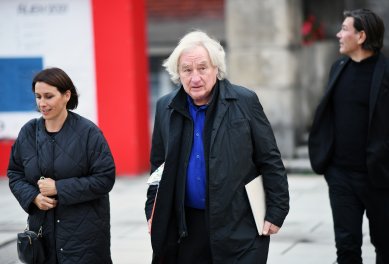
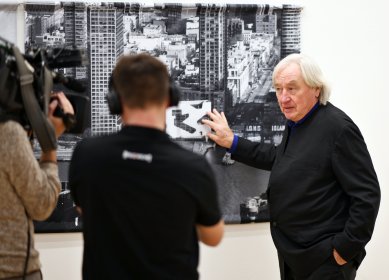
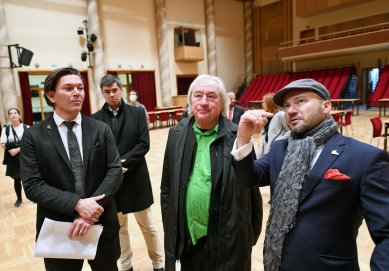
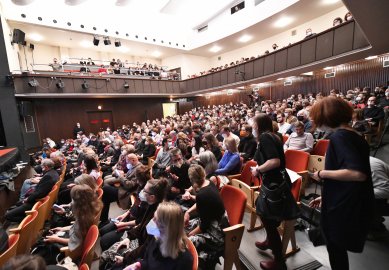
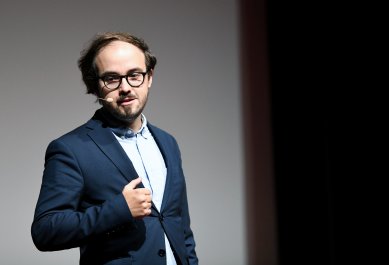

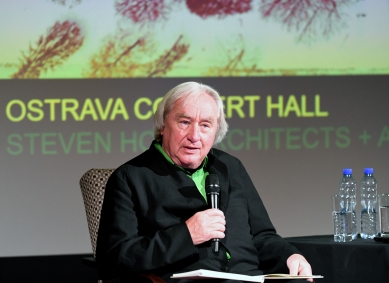
0 comments
add comment
Related articles
0
20.12.2021 | The interior model of the Ostrava concert hall is complete
0
18.11.2021 | Steven Holl. Making Architecture - extension of the exhibition in Ostrava
0
14.10.2021 | Debate: Steven Holl in Ostrava
0
28.09.2021 | To the exhibition of Steven Holl in Ostrava
0
18.09.2021 | Steven Holl. Making Architecture - exhibition in Ostrava






